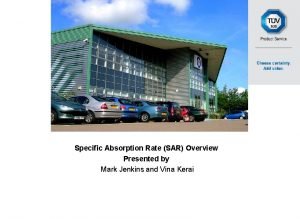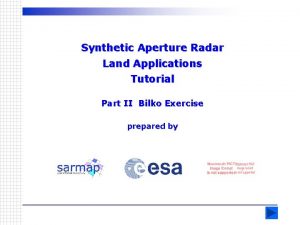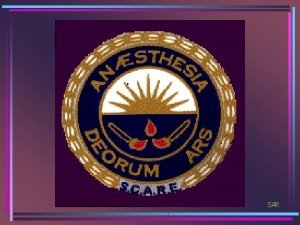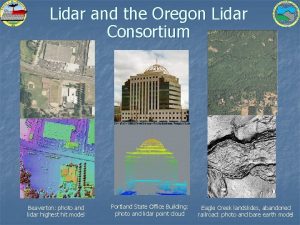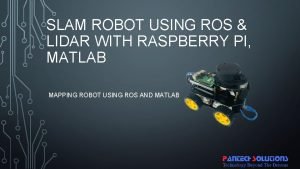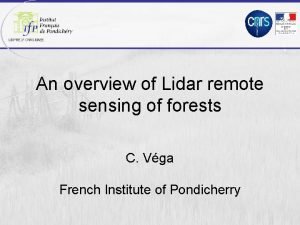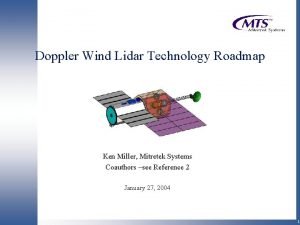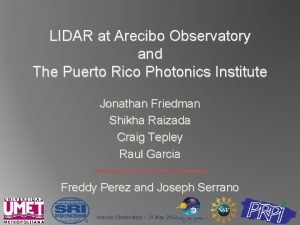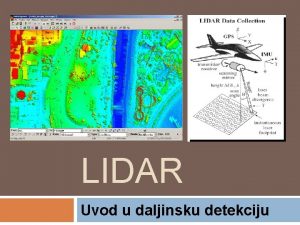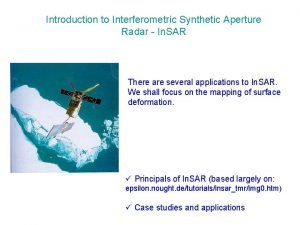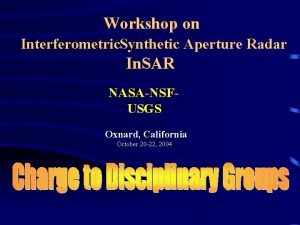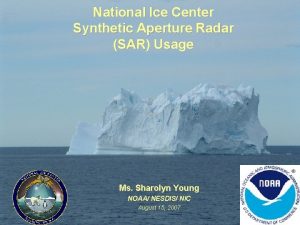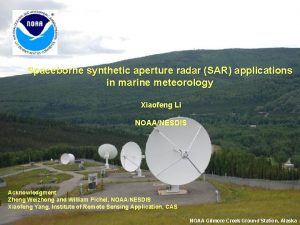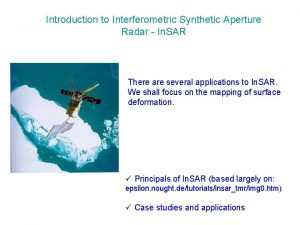SAR Investigation Synthetic Aperture LIDAR SAL ZEUS GANNON





![With Great Bandwidth Comes Great Resolution • From a 2012 thesis [1] an image With Great Bandwidth Comes Great Resolution • From a 2012 thesis [1] an image](https://slidetodoc.com/presentation_image_h2/550b21b42ec2789b30e6815305aae58a/image-6.jpg)




![References [1] Crouch, Stephen. “SYNTHETIC APERTURE LADAR TECHNIQUES. ” MONTANA STATE UNIVERSITY, 2012. [2] References [1] Crouch, Stephen. “SYNTHETIC APERTURE LADAR TECHNIQUES. ” MONTANA STATE UNIVERSITY, 2012. [2]](https://slidetodoc.com/presentation_image_h2/550b21b42ec2789b30e6815305aae58a/image-11.jpg)
- Slides: 11

SAR Investigation: Synthetic Aperture LIDAR (SAL) ZEUS GANNON

Motivation for SAL • Smaller wavelengths (μm vs cm) • Wider bandwidths (THz) • Possible real time processing? [4] • Lasers are cool Figure 0: Knife edge measurement of a laser beam

In the Beginning • NRL published the first laboratory demonstration of 2 -D SAL in 2002 [2] • Most of the experiment and processing struggles were compensating for the chirp nonlinearities. • Chirp of 10 nm (1. 2 THz) Figure 1: NRL Experimental setup [2]

Let There Be Light • This first experiment had a resolution of 90 μm by 170 μm • Required strict laboratory conditions [2] [2]

Technological Advancements • The challenge with early lasers could be described as “generally, tunable sources are not sufficiently stable, and stable sources are not broadly tunable [3]” • Bridger Photonics and Spectrum Lab developed a broad band tunable laser source with up to 5 THz bandwidth [3] Figure 5: Experimental setup for broadband optical frequency chirp linearization using the self-heterodyne technique. [3]
![With Great Bandwidth Comes Great Resolution From a 2012 thesis 1 an image With Great Bandwidth Comes Great Resolution • From a 2012 thesis [1] an image](https://slidetodoc.com/presentation_image_h2/550b21b42ec2789b30e6815305aae58a/image-6.jpg)
With Great Bandwidth Comes Great Resolution • From a 2012 thesis [1] an image with a resolution of 50 μm by 50 μm was produced using a 3 THz chirp • Employed the Phase Gradient Autofocus (PGA) technique • Interferometric SAL was also demonstrated • Short range due to optical power requirements • More vulnerable to atmospheric conditions Figure 6: SAL image of a dragonfly [1]

Return of Optical Processing • SAR was originally processing using film and lens transforms • Film can’t be changed after it’s produced • Digital became easier to use as ADC technology advanced Figure 7: Early optical SAR processing [4]

Return of Optical Processing • Using Spatial Light Modulators (SLM) a digital signal can be presented to an optical system using holography [4] • This allows a SAL image to be processed optically after the Phase Gradient Autofocus technique is applied. • Allows for real-time SAL processing up to 60 Hz Figure 8: Opto-mechanical design [4]

Recent Work • Claims of 3 D ISAL at distances of 1 km in 2018 [5] Figure 9: Experimental setup [5] Figure 10: 3 D imaging “result” [5]

Questions?
![References 1 Crouch Stephen SYNTHETIC APERTURE LADAR TECHNIQUES MONTANA STATE UNIVERSITY 2012 2 References [1] Crouch, Stephen. “SYNTHETIC APERTURE LADAR TECHNIQUES. ” MONTANA STATE UNIVERSITY, 2012. [2]](https://slidetodoc.com/presentation_image_h2/550b21b42ec2789b30e6815305aae58a/image-11.jpg)
References [1] Crouch, Stephen. “SYNTHETIC APERTURE LADAR TECHNIQUES. ” MONTANA STATE UNIVERSITY, 2012. [2] M. Bashkansky, R. L. Lucke, E. Funk, L. J. Rickard, and J. Reintjes, Two-dimensional synthetic aperture imaging in the optical domain, Opt. Lett. 27, 1983 (2003). [3] Peter A. Roos, Randy R. Reibel, Trenton Berg, Brant Kaylor, Zeb W. Barber, and Wm. Randall Babbitt, "Ultrabroadband optical chirp linearization for precision metrology applications, " Opt. Lett. 34, 3692 -3694 (2009) [4] Simon Turbide, Linda Marchese, Marc Terroux, François Babin, Alain Bergeron, "An all-optronic synthetic aperture lidar, " Proc. SPIE 8542, Electro-Optical Remote Sensing, Photonic Technologies, and Applications VI, 854213 (19 November 2012); https: //doi. org/10. 1117/12. 974754 [5] Di Mo, Ran Wang, Ning Wang, Tian Lv, Ke-Shu Zhang, and Yi-Rong Wu, "Three-dimensional inverse synthetic aperture lidar imaging for long-range spinning targets, " Opt. Lett. 43, 839 -842 (2018)
